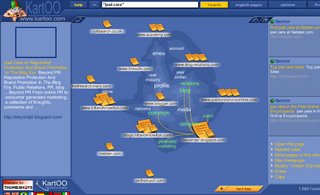Fantastic documentary from Sut Jhally that was shown in an elective at school. A video preview can be found on Youtube as well as on the Media Education Foundation website.The documentary’s main points can be found here .
Tags:
Fantastic documentary from Sut Jhally that was shown in an elective at school. A video preview can be found on Youtube as well as on the Media Education Foundation website.The documentary’s main points can be found here .
Tags: advertising, jhally

Campaign (
I’d like to see that for PR agencies now. PR Week anyone?

I saw it last week-end in
I came across this story through Steve’s bellicose posting. I started to write a contrarian post to defend Agency.com’s much mocked-after video pitch to Subway, diligently posted on Youtube for the world and its viruses to enjoy. However, after reading comments on AdFreak, Adrants and on Youtube, I changed my mind. There is ground for reputational damages.
I rarely comment on my public speaking engagements or publishing mentions but I decided to be more upfront. So with a total lack of subtlety, I am pointing out to two recent contributions: an article on blogs in Corp Comms magazine and a merit award for Atticus, WPP's thought-leadership magazine for the piece I submitted to Global PR Blog Week 2.0. last year. Apparently it will be published in the next issue.
From Publishing 2.0. quoting an article from the FT where the Chief Executive of Mediavest
I understand Mediavest's concerns: they are not making a lot of money when their clients spend their media budgets on Google AdWords v. TV or online ads. And yes, most advertisers are still in the dark as to how AdWords work.
Yet, to advertisers 1.0's credits, their brand (and clickthroughs to their sites) would certainly benefit from having pictures or videos displayed in search results. Google AdSense already does that with click-to-play video ads. When searching for designer perfume, to use Publishing 2.0. 's example, I could tolerate some visual ads in the sponsored results. This is the thin line between providing me with relevant information and enticing me to click and as long as these two do not contradict each other, why not? Note of caution: I would recommend Google to test whether its users would accept seeing Google’s purist white layout turned into a billboard before wide-scale rollout…In the meantime, advertisers will have to relearn writing compelling copy.

Just enter the email addresses of the people you want to share a given document, and then send them a message.
People with whom you share a given spreadsheet can access it as soon as they sign in.
Multiple people can edit or view your spreadsheet at the same time as you - their names will appear in an on-screen chat window.
There's nothing to download; you access your spreadsheets from any computer with an Internet connection and a supported browser.
Online storage and auto-save mean you need not fear hard drive failures and power outages.
The London School of Economics (LSE) compared the results of a telephone survey on a random sample UK consumers against the 2003 and 2004 sales data from companies mentioned in the survey. They found that word-of-mouth, both positive and negative were statistically significant predictors of sales growth.
See press release on LSE's website.
I am reproducing a quote verbatim from Sir Martin Sorrell which sums-up clients' mood:
“The IPA Bellwether report confirms our experience. The UK remains one of the weakest geographical markets at the moment. But new media and new technologies are growing rapidly as clients experiment with different approaches and question the value of traditional media.”
See Google's blog announcement (is that the end of the press release?!)
I will try to share some of these insights and these examples over the next few days, when I will digest them, now that I can.